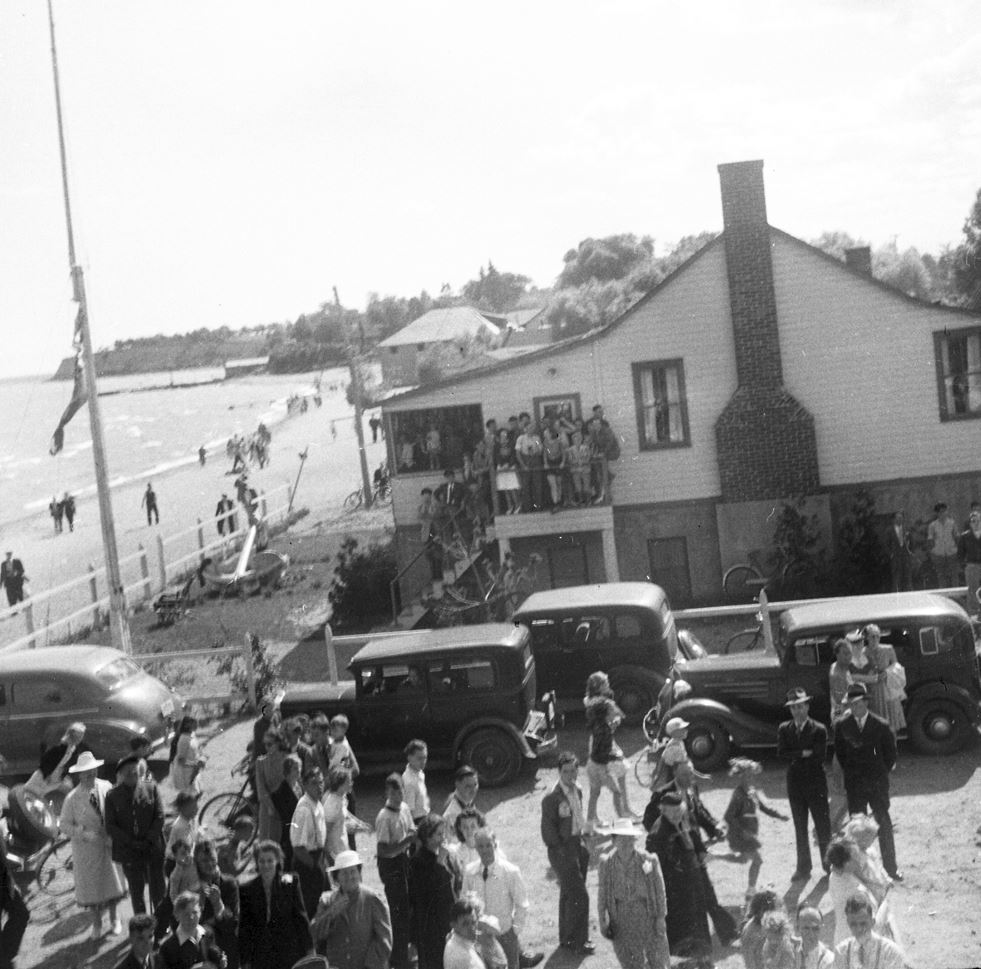Whitby Yacht Club Anchor

Source: Oshawa Museum, Archival Collection
Author: Robert B. Townsend
Audio Ready by: William Eby
Date: 1990s
Duration: 5:01
Image: Bruce Henderson, c/o Melissa Cole
Date: 1940s
This audio clip was written by Richard B. Townsend for the members of the Whitby Yacht Club. The anchor that sits at the Whitby Yacht Club today was originally found in the Oshawa Harbour.
Whitby Yacht Club Anchor
By: Robert B. Townsend
The Anchor was donated to The Whitby Yacht Club when the Oshawa Yacht Club was dissolved, and its members, by & large, moved to Whitby. It was discovered off Oshawa in August of 1934, a year when “old Lake Ontario” had gone down further than it had ever dropped before, as far as we know. Members of the old Oshawa Yacht Club (the predecessor of the Whitby Yacht Club)), Earl Sharp and Al Talbot, in particular, found the anchor in the lake and dragged it ashore. This was near the old clubhouse on the lake. How they recovered the Big Anchor would probably fill a book on engineering, for the thing weighs about three tons and would defy an ordinary windlass and cathead available to them in 1934. It is certainly not a ship’s anchor or an ordinary mooring anchor. It has been suggested that this monster was a draw-anchor or great kedge used for heaving vessels off at Oshawa, and this appears to be most probable. Placed permanently at a convenient distance from the old pier, so that any vessel caught with the wind on-shore could run a line to it, heave off from the pier, and slip her cable as soon as sail was made. The anchor would always be marked with a buoy and buoy-rope. Or perhaps the anchor was provided for the specific purpose of getting new ships off the beach and into the water during Oshawa’s short vessel building era. It is a curious fact that Port Oshawa, without any harbour until the present one was built for General Motors and other industries in 1930 or 1931, was not only a shipping point of considerable importance, but was the birth place of a number of schooners, built about the time of the Crimean War or earlier. The Schooners Omar Pacha, 95′ long, 26 feet six inches beam and nine feet two inches deep in the hold, and the Paragon, of the same size, were built near the Oshawa Beach, in 1853, and the Barque Allies in 1855, the Joshua J. Beard the following year. These later vessels were 400 tons measurement, or about 127 feet 6 inches long, 23 feet 6 inches beam and 10 feet 5 inches depth of hold. This was the size of a vessel designed to fit the second Welland Canal. These vessels were built east of the current harbour and had to be launched into the open lake. Skids would be built down to the water’s edge and continued out for a short distance, and well greased. Then lines would be carried from the windlass and capstan of the newly built vessel to the Big Anchor, (or was it a number of smaller ones). With wedges and pries she would be inched down the sloping ways until she struck at the water’s edge. Then, with vast heaving and grunting of crews on capstan bars and more men hauling tackles made fast to the hawsers leading to the anchors, the vessel would be warped off the ways and out to the mooring. Of course, a smooth day would have to be chosen for such a job, and as soon as the new vessel was afloat she would be towed to the wharf, or up to the safety of Whitby harbour or down to Port Hope, for rigging. That was possibly the purpose for the Club’s Big Anchor with the big palms and flukes buried in the lake bed – heaving off some new vessel drawing three or four feet of water “light” and without her spars, but an important addition to the lake commerce of her time. Whether it was used as a kedge anchor to assist vessels off the old pier, or to launch new vessels, I believe the Whitby Yacht Club should be very proud to have this important artifact to remind them of our very significant marine heritage.

